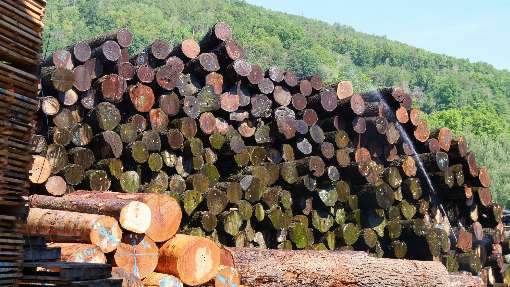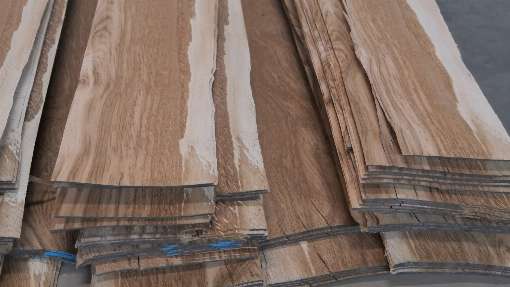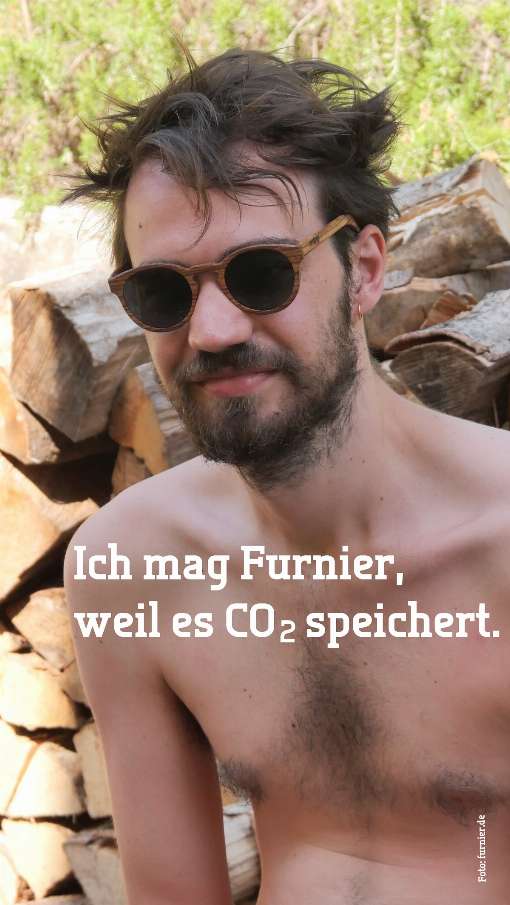27.05.2020
A good veneer tree is as rare as the proverbial needle in a haystack. It must be beautiful in growth, but only experts can recognise and judge its inner qualities. Types of trees such as maple, beech, oak, ash or walnut - mostly from Europe - are usually used to produce veneer. Perfect for felling the tree is the late winter: "Until March, the air is usually cold and dry and the tree does not yet develop new shoots. Its wood is also dry and therefore not as heavy as in summer. The mature tree is harvested in its winter resting period", explains Ursula Geismann, Managing Director of the Initiative Furnier + Natur (IFN). Once the tree has arrived at the veneer factory, it is treated with rustic equipment. First, all the logs are stacked on top of each other and properly watered. When the wood has absorbed enough moisture, the trees are stripped of their bark. Your wood is now more dynamic and can be sliced or peeled, depending on which veneer look is to be achieved. Peeling the tree works in a spiral around its own axis and slicing vertically, just like slicing bread. This produces very different veneer patterns. The thickness of the veneer depends, among other things, on the later use. Normally, a veneer sheet starts at a good 0.45 millimetres and ends at a good 6 millimetres; other thicknesses are also possible on request. The veneer sheets are then slowly and carefully dried. This prevents the wood from becoming wavy or cracking. Finally, the dried leaves are divided according to their quality and stacked according to type. After cutting, the individual sheets are then put together to form a so-called deck. For furniture surfaces, this is applied with glue and under high pressure to chipboard, MDF boards, multiplex boards, plywood or solid wood blockboards. Veneer sheets are now also widely used for ecological lifestyle products. There are veneer skis, glasses, bags, kiteboards, lamps, mouse-pads and much more. IFN
Initiative Veneer + Nature (IFN) Veneer + Nature Initiative
The Initiative Furnier + Natur (IFN) e.V. was founded in 1996 by the German veneer industry and its partners. Today, it is supported by European companies from the veneer industry, trade and veneer processing industry as well as professional associations of the timber industry. The aim of the association is to promote the natural all-round material veneer.
Photo 1: Veneer trees are watered in the storage area. Picture: IFN/Mehling + Wiesmann
Photo 2: A veneer tree is peeled. Picture: IFN/Mehling + Wiesmann
Photo 3: Veneer sheets waiting to be used. Picture: IFN/Mehling + Wiesmann
Photo 4: Spectacles and sunglasses made of veneer are extremely climate-friendly products. Picture: IFN
The second life of a tree: How veneer is made
Bonn. Veneer? What is veneer anyway? Yes, it has something to do with wood: Veneer is basically made from real, natural wood and is laboriously extracted. To turn a tree into veneer, the perfect specimen must first be found in the forest. The subsequent processing steps are also an art.A good veneer tree is as rare as the proverbial needle in a haystack. It must be beautiful in growth, but only experts can recognise and judge its inner qualities. Types of trees such as maple, beech, oak, ash or walnut - mostly from Europe - are usually used to produce veneer. Perfect for felling the tree is the late winter: "Until March, the air is usually cold and dry and the tree does not yet develop new shoots. Its wood is also dry and therefore not as heavy as in summer. The mature tree is harvested in its winter resting period", explains Ursula Geismann, Managing Director of the Initiative Furnier + Natur (IFN). Once the tree has arrived at the veneer factory, it is treated with rustic equipment. First, all the logs are stacked on top of each other and properly watered. When the wood has absorbed enough moisture, the trees are stripped of their bark. Your wood is now more dynamic and can be sliced or peeled, depending on which veneer look is to be achieved. Peeling the tree works in a spiral around its own axis and slicing vertically, just like slicing bread. This produces very different veneer patterns. The thickness of the veneer depends, among other things, on the later use. Normally, a veneer sheet starts at a good 0.45 millimetres and ends at a good 6 millimetres; other thicknesses are also possible on request. The veneer sheets are then slowly and carefully dried. This prevents the wood from becoming wavy or cracking. Finally, the dried leaves are divided according to their quality and stacked according to type. After cutting, the individual sheets are then put together to form a so-called deck. For furniture surfaces, this is applied with glue and under high pressure to chipboard, MDF boards, multiplex boards, plywood or solid wood blockboards. Veneer sheets are now also widely used for ecological lifestyle products. There are veneer skis, glasses, bags, kiteboards, lamps, mouse-pads and much more. IFN
Initiative Veneer + Nature (IFN) Veneer + Nature Initiative
The Initiative Furnier + Natur (IFN) e.V. was founded in 1996 by the German veneer industry and its partners. Today, it is supported by European companies from the veneer industry, trade and veneer processing industry as well as professional associations of the timber industry. The aim of the association is to promote the natural all-round material veneer.
Photo 1: Veneer trees are watered in the storage area. Picture: IFN/Mehling + Wiesmann
Photo 2: A veneer tree is peeled. Picture: IFN/Mehling + Wiesmann
Photo 3: Veneer sheets waiting to be used. Picture: IFN/Mehling + Wiesmann
Photo 4: Spectacles and sunglasses made of veneer are extremely climate-friendly products. Picture: IFN



